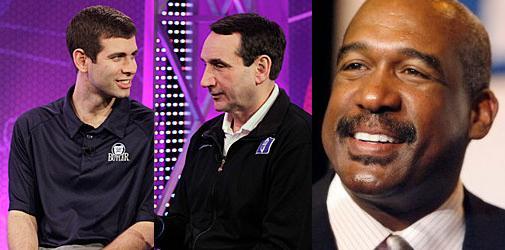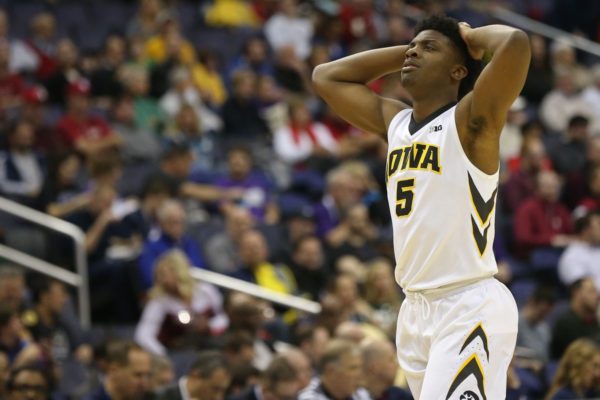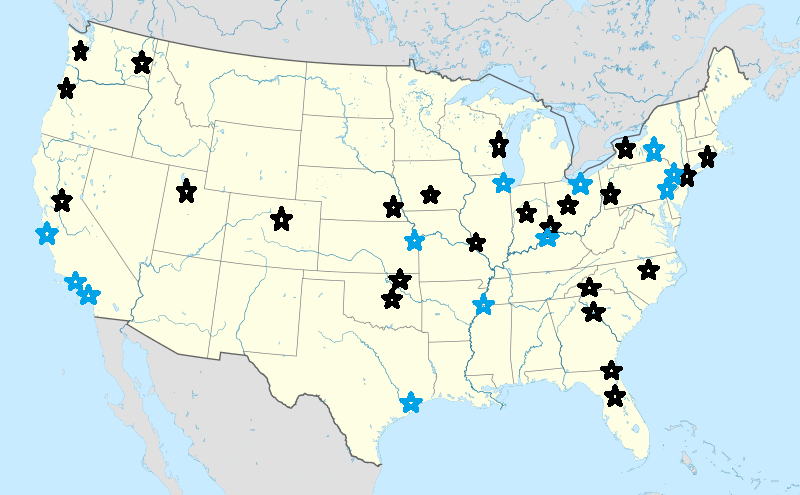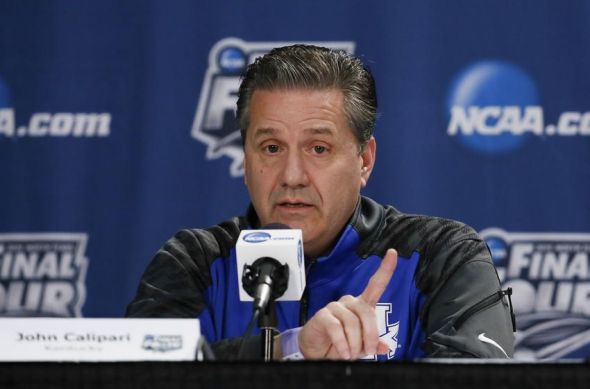Posted by rtmsf on November 18th, 2010
Yesterday the NCAA held a teleconference featuring Gene Smith, the current Chair of the Men’s Basketball Committee, Duke head coach Mike Krzyzewski, and Butler head coach Brad Stevens. The media was afforded the opportunity to ask questions of the three in a structured format, and while we didn’t have a question ourselves, there were quite a few interesting nuggets that came out of the event. Rather than simply posting the complete transcript, we pulled out the parts that we found most compelling for the sake of simplicity. (note: entire transcript can be found here)

Three Big Names in the Sport Fielded Questions Yesterday
The line of questioning that perked our ears the most revolved around the longstanding RTC complaint that the regular season trickles out in fits and twitches rather than exploding onto the sports scene as it should. All three interviewees in this teleconference agreed that such a thing is worth exploring.
-
Gene Smith: [This was discussed as] a casual conversation we had in our meetings in New Orleans last week. We were sitting around and realized that the games started, we were watching games. We really thought it would be nice if we had, at the beginning of the basketball season, an event of some nature that brought attention and awareness right off the bat on the first games right away. We’re blessed right now with the 24 Hours of Hoops Marathon just concluding. While that was going on, there was a great deal of excitement. In the first week, it didn’t seem to have the energy and excitement that we felt the start of the season should have. So it’s really a discussion we thought we needed to keep on our radars as we move forward.
-
Coach K: I’d be in favor of that. I think what happened yesterday was great for the game. It actually felt like the start of the basketball season. People watched those games, and they were great games. We should have an official start to the season and not let it start from November 4th or 8th. Nobody really knows when it starts. To kick it off like that was tremendous. That was a tremendous thing ESPN did.
-
Brad Stevens: Yeah, I think it’s really good. I say I’d like to see us play a little bit better when we open a place like yesterday. But I think it’s a great thing for college basketball. It brings awareness to college basketball. I think people get excited about it. Like Coach Krzyzewski said, people now know that the season has kicked off. I think sometimes towards the waning parts of the football season, or at least the regular season, all of a sudden pops up a college basketball game. It’s like, I didn’t realize that was going on.
Let’s hope that the NCAA continues its recent trend of listening to its constituents — the schools, coaches, and the fans — and figures out a way to make something like a true season tipoff event happen. Another area of inquirey that all three gentlemen addressed was how expanding the NCAA Tournament to 68 teams next year may impact the decision-making process of the Committee.
- GS: It’s really hard to speculate what that moment will bring for us. Our policies and procedures on selecting and seeding and bracketing will pretty much stay the same. We’ll move through our process. Now, as opposed to stopping, we’ll go to 37 at‑large. I just don’t see us changing anything. I still believe there’s going to be that 38th and 39th team that feel they should have been the 36th or 37th team. To my view, it will be a continued level of excitement from that perspective.
- BS: It helps four teams. I don’t know which four teams it helps. I don’t know they’re in any given league. I found it to be the case, I think they look at it really objectively and [Smith] addressed that. What we try to do is we try to go out and schedule the best schedule that we possibly can, which in the coaching fraternity they call me crazy for doing that, so that we at least have a shot to qualify for the tournament in two ways. At the end of the day it’s going to be the next four best teams, and certainly there’s going to be some arguments, there’s always going to be No. 69 and 70. But four more teams have a chance to get in. I don’t think it necessarily helps one program or another.
The proposal that the NCAA recently deliberated involving a banishment of the summer recruiting period was also discussed, and perhaps expectedly, neither coach was in favor of this measure.
- MK: First of all, I’d like to see legislation not put forward without input from coaches. This summer the conference commissioners voted to get rid of summer recruiting, and there wasn’t anybody from basketball representing the game at that meeting, which sometimes is the reason that poor legislation is passed concerning our game. We should always have a representative of basketball at committee meetings where they’re deciding things about our game. Summer recruiting is essential for schools of all levels. I think the amount of money that you would have to put into it if you didn’t have summer recruiting would be immense because you get to see so many kids during a short period of time in one area. So it’s essential. What we do with it, I mean, it should be a consensus with the coaches and our administrators as to what is best for our game. You’re going to have to do something in the summer, there’s no question about it. […] If people would cut out summer recruiting, it would be a huge mistake. Now, what we do with it, how we go forward, let’s figure out what’s in the best interest of our game, what’s in the best interest of all the schools involved. You’re going to need to go out in the summer. Kids are going to play in the summer. You’re going to need to go out or else you’re going to have to deal with more people who have no restrictions. They’re not answerable to any authorities as far as academic authorities. Less access that we put in the early ’90s proved to be poor for the game. To have further less access, you know, would be utterly ridiculous to do. We should have learned our lesson from that.
- BS: I’ve been in plenty of discussions with different coaches and people around. I think the key, like Coach K said, is more access, not less access. I think we all agree on that. We certainly can’t eliminate the July period. But if we can come up with a way to make it whether it means you have more access to juniors, you get more calls, whatever the case may be, then if you want to limit July or cut July back by a couple of days, add a weekend or two in April, have all kinds of scenarios that work. But you have to make it so we can watch these games, watch these kids all in one place or at least in a few different places. It’s very cost‑effective. I think it’s the right thing for us to do. I think it’s the right way to go. I don’t think you can, again, I don’t know that 20 days is the right thing. I think that’s a bit much personally because I think kids are tired, coaches are tired. It’s well documented how unhealthy the whole month is from that regard. If you could knock it back a couple days and add a couple days in April, I’d be all for it.
| randomness
| Tagged: brad stevens, butler, coach k, duke, First Four, gene smith, ncaa selection committee, ohio st, opening night, summer recruiting
Share this story













































